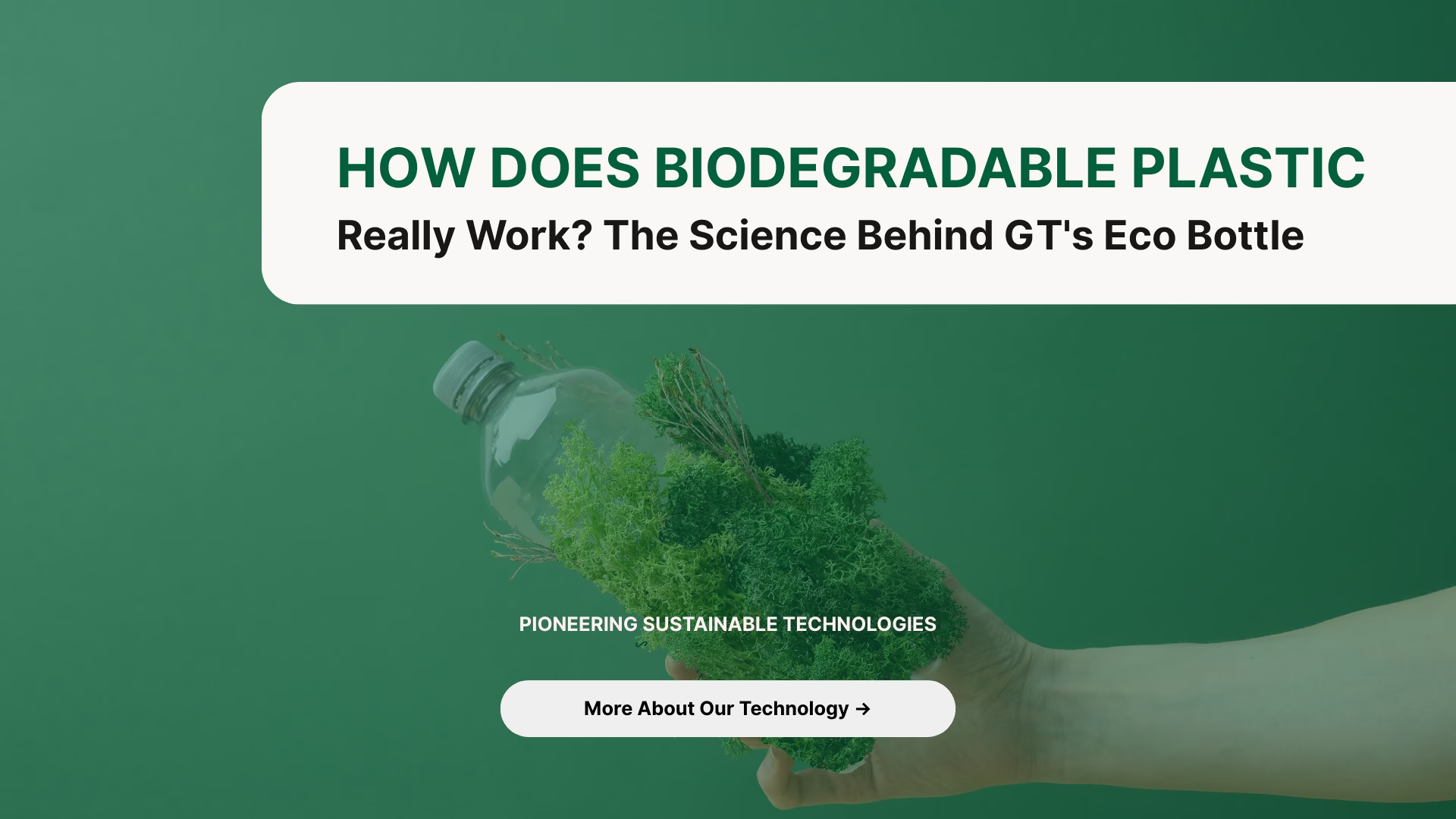The Science Behind GT’s Eco Bottle
The Greener Tech Group explains the depolymerization and microbial digestion process of biodegradable plastic.
Understanding the Science of Biodegradable Plastic
Biodegradable plastic is not just a buzzword—it’s a scientifically engineered solution to one of the world’s most pressing environmental challenges. Unlike traditional plastics that can persist in landfills for centuries, biodegradable plastics are designed to break down naturally and safely, leaving behind no toxic residue or microplastics.
But how exactly does this process work?
At the core of this innovation lies a unique technology that combines conventional plastic with an organic additive during manufacturing. This additive doesn’t change the look, feel, or performance of the plastic—but it changes what happens at the end of its life cycle.
When these bottles end up in landfill environments, microbes—naturally occurring microscopic organisms—recognise the material as a food source. They begin digesting it through a biological process known as depolymerization, which essentially mimics nature’s way of breaking down organic matter.
What Is Depolymerization?
Depolymerization is a biochemical process in which long-chain polymers—in this case, plastic—are broken down into their original monomers by enzymes secreted from microbes.
In simpler terms: instead of slowly fragmenting into smaller pieces like traditional plastics (which eventually become harmful nanoplastics), biodegradable plastics undergo a full molecular breakdown.
This means the plastic doesn’t just “disappear”—it transforms into natural elements through microbial action, ultimately becoming carbon dioxide, water, and natural biomass.
Importantly, this process leaves behind no microplastics, no toxic residues, and no persistent pollutants —making it a truly sustainable alternative to conventional plastic packaging.
The Role of Microbial Digestion
Microbes play a crucial role in the biodegradation process. When biodegradable plastic enters landfill or compost conditions, naturally occurring bacteria and fungi begin to colonise its surface.
These microbes secrete specific enzymes that target the weakened carbon bonds within the plastic structure. Over time—and under the right environmental conditions—the plastic begins to degrade at a molecular level.
What makes this method revolutionary is that it allows the plastic to be fully consumed by microorganisms, rather than simply breaking apart into smaller, invisible fragments that remain in the environment indefinitely.
This closed-loop system ensures that every component of the bottle is returned safely to the ecosystem, aligning with circular economy principles and eliminating plastic waste at the source.
Why This Matters for the Environment and Human Health
Traditional plastic pollution has reached crisis levels. A single litre of bottled water contains approximately 240,000 plastic particles, with 90% classified as nanoplastics —tiny enough to enter the bloodstream, cross into the brain, and even reach a developing fetus.
Studies published in the New England Journal of Medicine have linked microplastics in human arteries to increased risk of heart attacks, strokes, and early death. With global plastic production expected to triple by 2050, the urgency for change has never been greater.
Biodegradable plastic offers a viable solution—one that protects both the planet and public health.
How The Greener Tech Group Is Leading the Way
At the forefront of this movement is The Greener Tech Group, which is actively bringing verified, scalable, and scientifically backed biodegradable solutions to market.
One of its flagship innovations is the Eco Bottle, Australia’s first and only 100% biodegradable, reusable, and microplastic-free bottled water solution.
Unlike traditional plastic bottles made from polyethylene terephthalate (PET), the Eco Bottle uses enzyme-assisted depolymerization to ensure full biodegradation in landfill environments. This means consumers can enjoy safe, clean hydration without contributing to the growing health risks associated with plastic contamination.
By working directly with manufacturers, governments, and import/export partners, The Greener Technology Group helps bridge the gap between innovation and implementation—making sustainable alternatives more accessible and economically viable across industries.
Real-World Applications of Biodegradable Plastics
Biodegradable plastic technology is already being used across multiple sectors:
- Beverage Industry : Biodegradable bottled water containers are replacing traditional PET bottles, offering safer hydration without nanoplastic contamination.
- Packaging Industry : Companies are adopting enzyme-infused HDPE and LDPE materials to create fully biodegradable food packaging, medical supplies, and consumer goods.
- Agriculture : Biodegradable mulch films and plant-based packaging help reduce reliance on synthetic chemicals and prevent soil contamination.
- Retail and E-commerce : Brands are shifting toward sustainable product packaging that breaks down naturally, reducing landfill burden and ocean pollution.
These applications show that biodegradable plastic is not just a theoretical concept—it’s a practical, real-world solution already making a measurable impact.
Benefits of Biodegradable Plastic
Switching to biodegradable plastic offers a wide range of benefits:
- Eliminates microplastic release into food, water, and air
- Reduces landfill pollution and long-term environmental damage
- Supports circular economy models where waste becomes a resource
- Protects marine and terrestrial ecosystems from plastic accumulation
- Promotes public health by reducing exposure to harmful nanoplastics
With companies like The Greener Technology Group leading the way, biodegradable plastic is proving to be a powerful tool in the fight against plastic pollution.
Conclusion: A Sustainable Future Starts with Science
Biodegradable plastic represents a major breakthrough in sustainability science. By enabling full microbial digestion through depolymerization, it provides a realistic alternative to the environmental and health hazards posed by traditional plastics.
As awareness grows and demand increases, more businesses and consumers are choosing products that align with their values—products that protect both people and the planet.
With continued innovation and education, we can shift away from the current model of plastic dependency and move toward a future where plastic waste is no longer a threat to our health or the environment.
Key Summary
✓ Biodegradable plastic breaks down through depolymerization, allowing microbes to fully digest it without leaving microplastics.
✓ The process involves microbial digestion, where naturally occurring bacteria break down plastic into natural fertilizer and harmless byproducts.
✓ Traditional plastic releases up to 240,000 particles per liter of bottled water, mostly nanoplastics that enter the bloodstream.
✓ The Greener Technology Group’s Eco Bottle is Australia’s first and only 100% biodegradable,microplastic-free bottled water solution.
✓ Biodegradable plastics support public health protection, environmental regeneration, and global sustainability goals.
✓ This technology enables a closed-loop system, returning all components safely to the environment after use.

